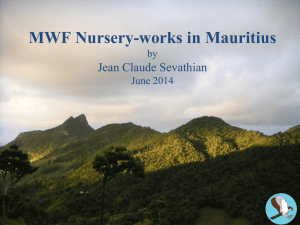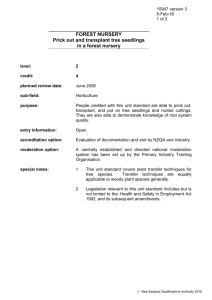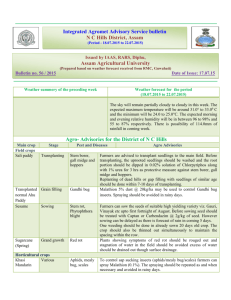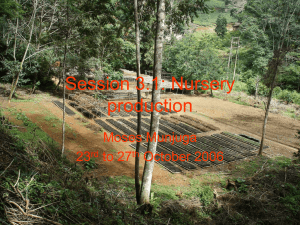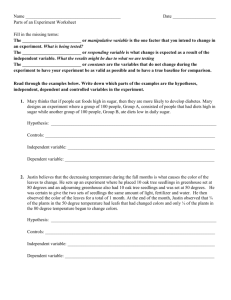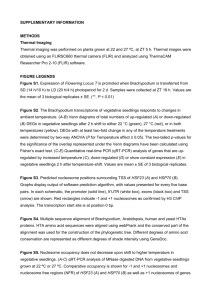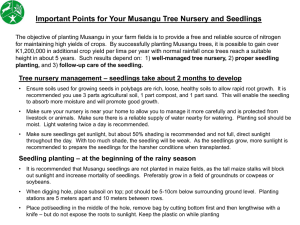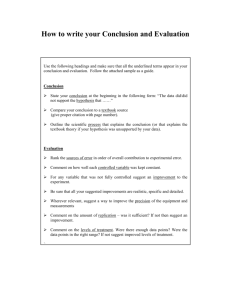Nursery Research
advertisement
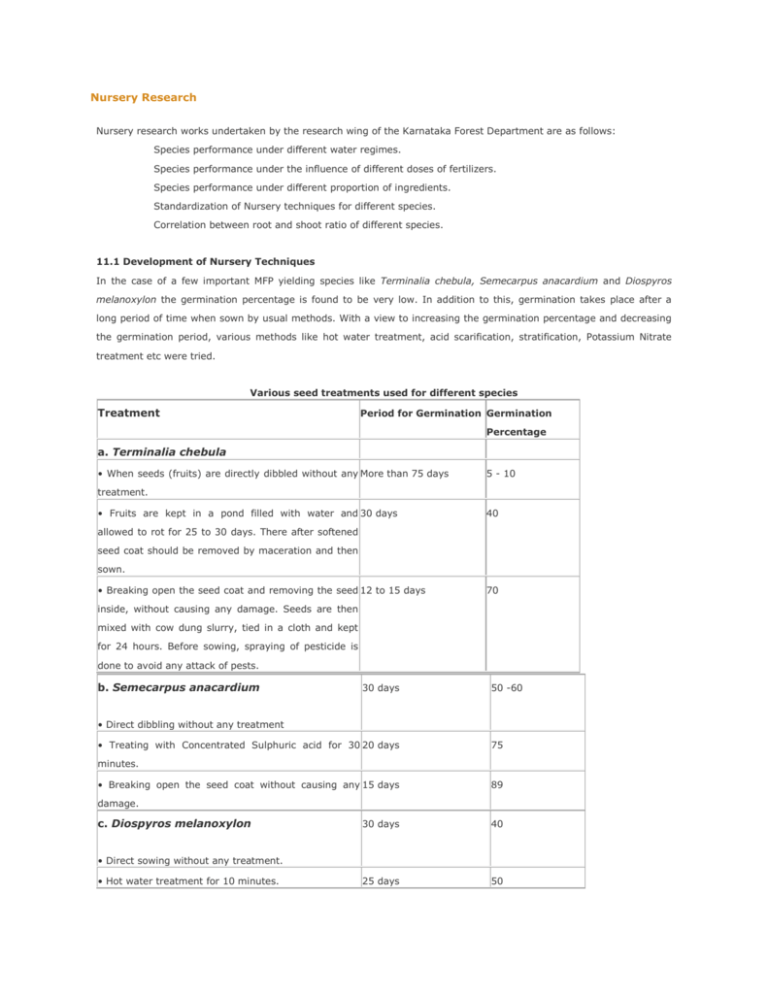
Nursery Research Nursery research works undertaken by the research wing of the Karnataka Forest Department are as follows: Species performance under different water regimes. Species performance under the influence of different doses of fertilizers. Species performance under different proportion of ingredients. Standardization of Nursery techniques for different species. Correlation between root and shoot ratio of different species. 11.1 Development of Nursery Techniques In the case of a few important MFP yielding species like Terminalia chebula, Semecarpus anacardium and Diospyros melanoxylon the germination percentage is found to be very low. In addition to this, germination takes place after a long period of time when sown by usual methods. With a view to increasing the germination percentage and decreasing the germination period, various methods like hot water treatment, acid scarification, stratification, Potassium Nitrate treatment etc were tried. Various seed treatments used for different species Treatment Period for Germination Germination Percentage a. Terminalia chebula • When seeds (fruits) are directly dibbled without any More than 75 days 5 - 10 treatment. • Fruits are kept in a pond filled with water and 30 days 40 allowed to rot for 25 to 30 days. There after softened seed coat should be removed by maceration and then sown. • Breaking open the seed coat and removing the seed 12 to 15 days 70 inside, without causing any damage. Seeds are then mixed with cow dung slurry, tied in a cloth and kept for 24 hours. Before sowing, spraying of pesticide is done to avoid any attack of pests. b. Semecarpus anacardium 30 days 50 -60 • Direct dibbling without any treatment • Treating with Concentrated Sulphuric acid for 30 20 days 75 minutes. • Breaking open the seed coat without causing any 15 days 89 damage. c. Diospyros melanoxylon 30 days 40 25 days 50 • Direct sowing without any treatment. • Hot water treatment for 10 minutes. • Treating with Gibberallic acid 500ppm 20 days 75 d. Emblica officinalis 30 days 40 • Direct sowing without any treatment. • Soaking the seeds in Gibberallic acid 500 ppm 10 to 12 days 70 for 6 hours. e. Santalum album 90 days 75 20 days 95 80 days 20 • Alternate soaking and drying in cold water. 20 days 75 g. Pterocarpus santalinus 80 days 30 • Soaking seeds in cow dung slurry for 3 days, 15 days 50 • Direct sowing without any treatment. • Phyto-sanitary treatment with 0.2per cent Agallol for 30 minutes, followed by overnight soaking in 0.5per cent Gibberallic acid. f. Melia dubia • Direct sowing without any treatment. • Direct sowing without any treatment. wrapping with gunny bag and weighing it down. Raising of Tall Seedlings Practice of growing seedlings in small polybags for the purpose of raising plantations on roadside and in urban areas did not work satisfactorily due to damage caused by cattle. In order to avoid cattle damage, the department has developed a technique to grow tall seedlings of forest tree species, which are usually planted in avenue plantations in very short time of about less than 6 months. In this technique it is possible to raise seedlings of 2m to 3m height in bigger poly bags of size 14”x20”. The success is very good. A small booklet “Raising of Tall seedlings of Forest Trees” has been published by the Silviculturist, Northern Zone, Dharwad during the year 2001. 11 .2 Vegetative propagation Successful vegetative propagation programmes would require development of appropriate environmental control devices for maintaining optimum humidity, temperature and light. Further there should be a proper method to control the growth of pathogens. Two major methods used in vegetative propagation are hetro-vegetative (grafting) and auto vegetative (rooting and cutting). Different methods of vegetative propagation used for different species are given in Table 42. In 1979 a Mist chamber was set up at Mudugere. Species like Ficus infectoria , Ficus glomerata , Peltophorum ferruginatum, Delonix regia, Samanea saman and Bambusa vulgaris were tried. There was 100 per cent sprouting in all the species. Hydro pits : Pits of 1m x1m x 1m were opened and filled with sand with plastic sheet underneath. Grafted seedlings were placed in the pit and sufficient irrigation was provided. The pit was closed with UV polythene sheet. It acts as a low cost green house. This is a labour saving device. The grafted seedlings can be removed in 3 weeks. Temporary poly tents: Small fabricated tents of the size 1m x1m x 1m were found to be most useful as it could be installed under the mother tree. Moist sand layer is provided to provide green house condition. The time spent in scion transportation is shortened, allowing for greater retention of turgidity of scions and better success. Stem cutting experiments a). Paulownia fortunei : Ordinary root cuttings of pencil thickness were treated with root hormones. They rooted successfully under green house conditions. Eucalyptus and Acacia hybrid clonal propagation: Single node cuttings of Eucalyptus and Acacia hybrid b). from coppice shoots of 45 days were treated with 6000ppm and 4000ppm of IBA and Quick dip solution, respectively and used for clonal multiplication. It resulted in 80 per cent rooting after 15 days. Stem Cuttings: The twig cuttings of Paulownia fortuni, Gmelina arborea, Dalbergia sissoo, Acacia c). auriculiformis, Anogeissus latifolia, Santalum album and Tectona grandis were treated with root hormones and placed in mist chambers. This did not give successful results. Bamboo: d). Rhizome cuttings of Oxytenanthera stocksii, Thyrostachys oliveri, Bambusa bamboos, Dendrocalamus gigantium were tried for rooting at Mudugere and Doresanipallya. All species responded well except Dendrocalamus gigantium . Stump based seedling production in Root trainer: The advantages of root trainers are that tap root formation in the plant is promoted, volume of ingredients used is reduced, and nursery period is shortened. e). Stump based production of seedlings was undertaken in root trainers. Uniformly tall seedlings of Pterocarpus marsupium, Dalbergia latifolia, Gmelina arborea, Azadirachta indica and Hardwickia binata were produced within 3 months. GRAFTING a). Softwood Grafting: Soft wood grafting is a substitute for approach grafting. It is used successfully for almost all the species. Low cost poly tents/houses are used for raising softwood-grafted seedlings. Top working: Top working was successfully employed for Emblica officinalis and Tamarind. The process b). involved pollarding the tree to knee height and there after wedge grafting was carried out on new shoots. This gave successful results. Raising seedlings for preparing root and shoot cutting for planting in dry zone The main reasons for drying of seedlings planted in the dry zone are paucity of moisture for prolonged periods and the scorching effect of the hot summer. Therefore it is necessary that the planting material should have sufficient store of food to withstand the prolonged dry period. For this, seeds of native species were sown in seedbeds. When the seedlings were about 5cm to 7cm in height, they were transplanted to nursery beds in rows at a spacing of 6cm x 6cm. This way the seedlings developed thick shoot and root. The seedlings were maintained in the nursery for one year. About three months prior to planting, root and shoot cuttings of about 15cm to 20cm length were prepared in poly bags of 20cm x 30cm size. The species raised were Hardwickia binata, Chloroxylon swietenia, Anogeissus latifolia, Albizzia amara, Albizzia lebbek, Pongamia Pinnata, Acacia sundra and Ailanthus excelsa. The seedlings raised were planted during 1990 planting season and the performance is being monitored. Clonal Nurseries Clonal nurseries have been established in all the silvicultural divisions of the state. The clonal nursery is divided in to three main areas. They are: a). Container and cutting preparation area b). Greenhouse c). Area for development of cuttings The species tried were Eucalyptus and Acacia auriculiformis . The results were encouraging. Important achievements in nursery research: This species was planted in the year 1969 at Mallipatna of Thitimathi Range in an area of 0.2 ha. The plantation is successful with survival percentage of 80. The trees were healthy with 80.0cm average girth and 24.0m height as recorded in the year 1987. a). Soft wood grafting technique has been standardized for Tamarindus indica, Artocarpus heterophyllus, Emblica officinalis, Annona squamosa, Syzygium cumini, Feronia elephantum and Sapindus emarginatus. b). Low cost poly house and hydropits were devised and were efficient in providing green house conditions. c). Top working of young Tamarind trees up to 30cm girth has been done successfully. d). e). f). g. The Introduction of root trainers in the nursery has led to reduction in the period of growth. Further, it has resulted in use of less mixture and space optimization. A new way of grafting 45 days old Tamarind rootstock gave success rate on par with 9-month-old rootstock. A new trial was conducted in which polytents of size 3' x 6' were fabricated and grafting of Jackfruit seedlings was done under the mother tree. This yielded a success rate of 60.7 per cent besides ensuring clonal fidelity. VAM production has been undertaken in the nurseries.
